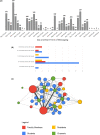Converting to Connect: A Rapid RE-AIM Evaluation of the Digital Conversion of a Clerkship Curriculum in the Age of COVID-19
- PMID: 33150275
- PMCID: PMC7592819
- DOI: 10.1002/aet2.10498
Converting to Connect: A Rapid RE-AIM Evaluation of the Digital Conversion of a Clerkship Curriculum in the Age of COVID-19
Abstract
Background: With the advent of the 2019 coronavirus pandemic, a decision was made to remove medical students from clinical rotations for their own safety. This forced students on a core emergency medicine (EM) rotation at McMaster University to immediately cease all in-person activities. An urgent need for a virtual curriculum emerged.
Methods: A virtual curriculum consisting of asynchronous case-based learning on Slack, ask-me-anything webinars, and online e-modules was created to fill the need. We describe a program evaluation using the RE-AIM framework and a social networking analysis of participants.
Results: Medical students (n = 23) and 11 facilitators (five residents, six faculty members) participated in this pilot study. Faculty members sent a mean (±SD) of 115 (±117) messages (n = 6), and mean (±SD) message counts for students and residents were 49.96 (±25; n = 23) and 39 (±38; n = 5), respectively. A total of 62,237 words were written by the participants, with a mean of 1,831 per person. Each message consisted of a mean (±SD) of 25 words (±29). Students rapidly acquitted themselves to digital technology. Using the RE-AIM framework we highlight the feasibility of a virtual curriculum, discuss demands on faculty time, and reflect on strategies to engage learners.
Conclusions: The use of asynchronous digital curricula creates opportunities for faculty-resident interaction and engagement. We report the successful deployment of a viable model for undergraduate EM training for senior medical students in the COVID-19 era of physical distancing.
© 2020 by the Society for Academic Emergency Medicine.
Figures

Similar articles
-
Management of Poisoned Patients: Implementing a Blended Toxicology Curriculum for Emergency Medicine Residents.J Educ Teach Emerg Med. 2022 Apr 15;7(2):C1-C32. doi: 10.21980/J8C937. eCollection 2022 Apr. J Educ Teach Emerg Med. 2022. PMID: 37465448 Free PMC article.
-
An Emergency Medicine Virtual Clerkship: Made for COVID, Here to Stay.West J Emerg Med. 2021 Dec 17;23(1):33-39. doi: 10.5811/westjem.2021.11.54118. West J Emerg Med. 2021. PMID: 35060858 Free PMC article.
-
Virtual Telesimulation for Medical Students During the COVID-19 Pandemic.Acad Med. 2021 Oct 1;96(10):1431-1435. doi: 10.1097/ACM.0000000000004129. Acad Med. 2021. PMID: 33883398 Free PMC article.
-
HEAL: an instructional design model applied to an online clerkship in family medicine.Acad Med. 2002 Sep;77(9):925-6. Acad Med. 2002. PMID: 12228093 Review.
-
Implementation and Evaluation of a Formal Virtual Medical Student Away Rotation in Orthopaedic Surgery During the COVID-19 Pandemic: A Single Institution Pilot Experience.JB JS Open Access. 2021 Aug 25;6(3):e21.00037. doi: 10.2106/JBJS.OA.21.00037. eCollection 2021 Jul-Sep. JB JS Open Access. 2021. PMID: 34476323 Free PMC article. Review.
Cited by
-
Reimagining Residency Selection: Part 1-A Practical Guide to Recruitment in the Post-COVID-19 Era.J Grad Med Educ. 2020 Oct;12(5):539-544. doi: 10.4300/JGME-D-20-00907.1. J Grad Med Educ. 2020. PMID: 33149819 Free PMC article. No abstract available.
-
Beyond COVID-19: the impact of recent pandemics on medical students and their education: a scoping review.Med Educ Online. 2023 Dec;28(1):2139657. doi: 10.1080/10872981.2022.2139657. Med Educ Online. 2023. PMID: 36331873 Free PMC article.
-
RE-AIMing COVID-19 online learning for medical students: a massive open online course evaluation.BMC Med Educ. 2021 May 27;21(1):303. doi: 10.1186/s12909-021-02751-3. BMC Med Educ. 2021. PMID: 34039344 Free PMC article.
-
Program evaluation: An educator's portal into academic scholarship.AEM Educ Train. 2022 Jun 23;6(Suppl 1):S43-S51. doi: 10.1002/aet2.10745. eCollection 2022 Jun. AEM Educ Train. 2022. PMID: 35783081 Free PMC article.
-
Incorporating implementation science principles into curricular design.AEM Educ Train. 2024 May 27;8(3):e10996. doi: 10.1002/aet2.10996. eCollection 2024 Jun. AEM Educ Train. 2024. PMID: 38808130 Free PMC article.
References
-
- Rose S. Medical student education in the time of COVID‐19. JAMA 2020;323:2131. - PubMed
-
- Hayes K, Feather A, Hall A et al Anxiety in medical students: is preparation for full‐time clinical attachments more dependent upon differences in maturity or on educational programmes for undergraduate and graduate entry students? Med Educ 2004;38:1154–63. - PubMed
-
- Chan TM, Gottlieb M, Sherbino J et al The ALiEM Faculty Incubator: a novel online approach to faculty development in education scholarship. Acad Med 2018;93:1497–502. - PubMed
LinkOut - more resources
Full Text Sources

